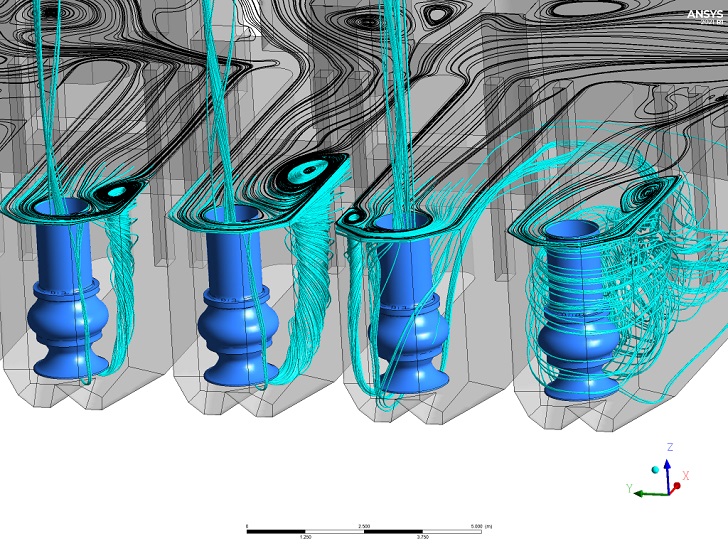Termomeccanica Pompe has always been striving to keep ahead of the game through innovation, consistently investing in technological & quality improvement of products/services, processes and manufacturing.
This article illustrates how the company’s R&D Department makes use of big data strategies and CFD tools to optimize waterintake design both in terms of performance and development time through the presentation of a recent case study it conducted and officially presented during ME RoTIC 2021 – the Middle East Rotating Machinery Technology & Innovation Conference – mid-November in Dubai.
The case study actually focuses on the optimization of CFD analysis through the use of big data methods based on statistical approach which allows to reduce the total simulation time.
Waterintake design studies Waterintakes of a pumping station are large civil works located on seacoasts or along the banks of rivers or shores of lakes. The usual layout of a waterintake consists of a forebay and several sump intakes on which vertical turbine pumps are installed. Typical operative conditions of waterintakes require that some pumps are turned off as spare units.
The Hydraulic Institute (HI) Standards define the guidelines for the design of a reliable waterintake, giving the main dimensions of the structure as a function of the inlet diameter of the pump. In this case, the proper operation of the waterintake is guaranteed by the HI standard and no additional action is necessary to improve the quality of the flow.
Whenever the real dimensions of the civil works are not in compliance with the HI recommendations, a deep investigation of the flow crossing the waterintake is necessary in order to seek any uneven flow distribution near the pump inlet that could be responsible for unexpected vibrations and worsening of the hydraulic performances.
The best method to check such configurations suggested by HI std is the model test study, which requires the realization of a real scale model of the waterintake, based on Froude similitude. The test is able to verify the proper fluid dynamic behaviour of the crossing flow in two ways: a qualitative analysis that consists of the observation of the vortical activity near the pump (in terms of surface and sub surface vortexes) and a quantitative study, based on the measure of the prerotation and the axial velocity scatter on the inner part of the pump.
However, the large scale of the model (usual factor is 1:10) results very expensive and time-consuming, especially if a large number of different configurations has to be analysed (i.e. in the optimization phase of the waterintake).
CFD analysis In the optimization phase an alternative to the experimental model test is the analysis of a virtual waterintake by means of CFD (Computational Fluid Dynamic), which is very useful for the evaluation of the characteristics of the flow approaching the sumps and can easily be modified in order to analyse different geometric layouts.
The case study Termomeccanica Pompe conducted refers to a waterintake with eight vertical pumps (two units composed by four pumps) which is not in compliance with Hydraulic Institute standards. Four operative conditions were considered:
- scenario A: when all the eight pumps are turned on;
- scenario B: when only one pump is in standby-mode and seven pump are running;
- scenario C: for each unit one pump is turned off and three pumps are operating so, globally, two pumps are in standby and six pumps are operating;
- scenario D: two pumps on each unit are turned off and the whole waterintake has four pumps turned off and the other four pumps running at runout condition.
The CFD computational grid included i) the forebay, ii) the eight pumping cells, iii) the accurate geometry of the external shape of each pump.
Big data analysis The complete list of scenarios that should be simulated considering all the combinations of running and spare pumps in the waterintake, in addition to the heavy computational grid, is extremely time consuming so a data analysis methodology was applied in order to decrease the total number of cases to be analysed by CFD tools. Termomeccanica started by carrying out a campaign of CFD analysis by using a quasi-random DOE approach through the selection of a combinations of pumps turned on and off. The results of this campaign of calculations were filtered and a first set of worst-case scenarios was assessed.
Using the results of this analysis, different input and output variables were selected and several objective functions were defined in order to properly correlate the variables. The results showed that the complete range of worst-case scenarios was reached by a reduced number of CFD simulations, post-processed by statistical principles.
Conclusions As an engineered pumps solutions designer and manufacturer, Termomeccanica Pompe focuses on providing high value-added support to its customers and their projects from the get-go. This includes the use of 3D CFD modelling, alone or in combination to other tools, to optimize the design of its solutions both in terms of performance & development schedule.



